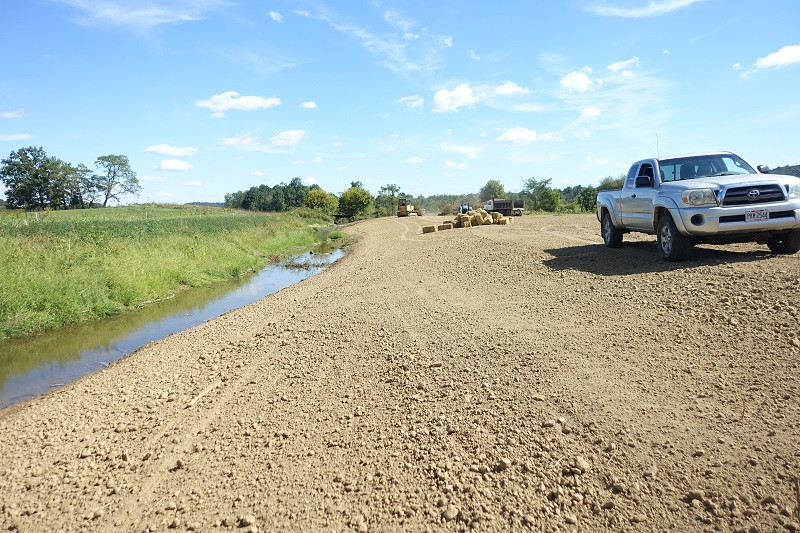Magical Streambanks
posted on
September 27, 2019

We continue restoring our streambanks.
We are gradually restoring and transforming a shallow but steep canyon back to a soft valley. About 100 years ago, this stream was straightened, or channelized, and the banks were mechanically carved to present a vertical drop to the water, in order to maximize acreage for crop production. Trees have since grown along this vertical drop, and regularly fall into the stream. Seasonal flood waters then carry bare soil of steep banks downstream, leaving behind eroded conditions.
We are not restoring the sinuosity of the stream, which would call for a monumental feat of engineering, but we are working on peeling back and softening the banks. As you can see on the far bank, where we worked last summer, established grass is holding soil in place. This will be followed by planting of willows and sycamores to stabilize the slope even further and also provide shade for aquatic life.


As you see above, current stream banks are about 6 - 8 feet straight down. Trees can't hold them in place, because of the vertical contour. The lower picture is of a corrugated outlet of a tile-line. About 8 feet of it is showing, while thirty years ago only two feet showed. So, during those thirty years, eroded dirt amounted to a volume of: six feet across by six feet high by 3,000 linear feet of topsoil, from that part of the streambank. Too many more decades of such erosion, and there will no longer be soil in this location on which to grow food. We will have gone the way of yet another lost civilization which chose to mistreat its topsoil.
We resist such fate, and are undertaking this enormous project one step at a time. It yields no immediate benefits, only costs, but in the long run is critical to our welfare. Topsoil is like morality; once gone it is hard to recover.
The steep bank generates anxiety, while the softened bank generates a feeling of peace and sustainability. The difference is magical.


An interesting discovery of this project was locating the foundry in which we assume the bricks of our fireplace were fired. While excavating, we came upon a collection of sandstone rocks atop of which laid a fair number of clay bricks, in various states of condition. We brought a partial brick to the house, washed it off, and matched it almost identically with several mortared into the fireplace. This feels like pretty clear proof the bricks of the fireplace were forged on the property, down by the creek.

The past Friday evening, we celebrated the Autumnal Equinox by hosting a magical gathering of great people of common vision in a beautiful location with excellent food, grown from well-stewarded topsoil. Susan is perfecting a recipe for beef stew, which was offered to the gathering, in addition to: vichysoisse soup, polenta, salad, spice cake, baked apples, and whipped cream. The group included our home-crew (the Freedom Team), a number of like-minded young farmers, and our neighbors who run the Arc of Appalachia. As the sun sank, we lighted lanterns and, before a fire, pondered the meaning of magic. A few said they did not believe in magic, but rather in miracles. Another referred to the discoveries of science as magical. Other descriptions included: love, hibernation, divinity, the bloom of Golden Rod, the innocence of childhood, the circle of life and death, the struggle of dreams, the building of community, order coming from chaos, a wild pool of water, a talk on a swing, and land being transformed... It was a fun and interesting topic, highlighting unexpected awe and reverence to be found in a day.

Marrow bones for beef broth, beef shoulder for stew meat, and rich gravy formed the heart of the beef stew, enjoyed on this magical evening.
May awe and reverence find their way to your streambanks, dinner gatherings, and beef stew!

Eddie, the rooster, provides nightly entertainment selecting the car-hood upon which to roost.







